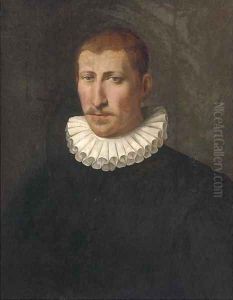Sofonisba Anguisciola Paintings
Sofonisba Anguissola was an Italian Renaissance painter born in 1532 in Cremona, Lombardy, then a part of the Duchy of Milan. She was the oldest of seven children in the Anguissola family, a minor noble family that was progressive in terms of the education of their daughters. Sofonisba's father, Amilcare Anguissola, recognizing her talent early on, ensured that she received a well-rounded education that included fine arts. Unlike many women of her time, Anguissola had the opportunity to study with established painters; her initial training was with Bernardino Campi and later with Bernardino Gatti.
Anguissola is best known for her portraiture, which was highly regarded for its attention to detail and psychological depth. She also painted religious themes and scenes of daily life. However, it was her portraits that garnered her fame and respect among her contemporaries. Her works were praised by Michelangelo, who once offered her advice after seeing a drawing she created. In 1559, she was invited to the Spanish court of Philip II, where she served as a lady-in-waiting and court painter to Elisabeth of Valois, the king's third wife. Sofonisba became an official court painter and was given an unprecedented level of recognition and independence for a female artist at that time.
In Spain, Anguissola's work influenced the Spanish painters of the time, including Diego Velázquez. Her presence at court and her role as a portraitist helped establish the genre's importance in Spanish art. After the death of Elisabeth of Valois, she continued to serve the royal family, tutoring the infanta Isabella Clara Eugenia in painting. Anguissola's later life was marked by personal loss and financial difficulties, yet she continued to paint. In 1620, she was visited by a young Flemish artist, Anthony van Dyck, who created a portrait of her and took notes on her painting technique, which provides valuable insights into her approach to art.
Sofonisba Anguissola's legacy is significant; she broke gender barriers in the art world and served as an inspiration for subsequent generations of female artists. Her work is characterized by a refined and sensitive portrayal of her subjects, often depicting them with a sense of dignity and poise. Her paintings can be found in major museums around the world, testifying to her enduring influence on the art of portraiture. Sofonisba Anguissola died in 1625 at the age of 93, leaving behind a body of work that continues to be studied and admired for its contributions to the Renaissance and to the history of women in art.
